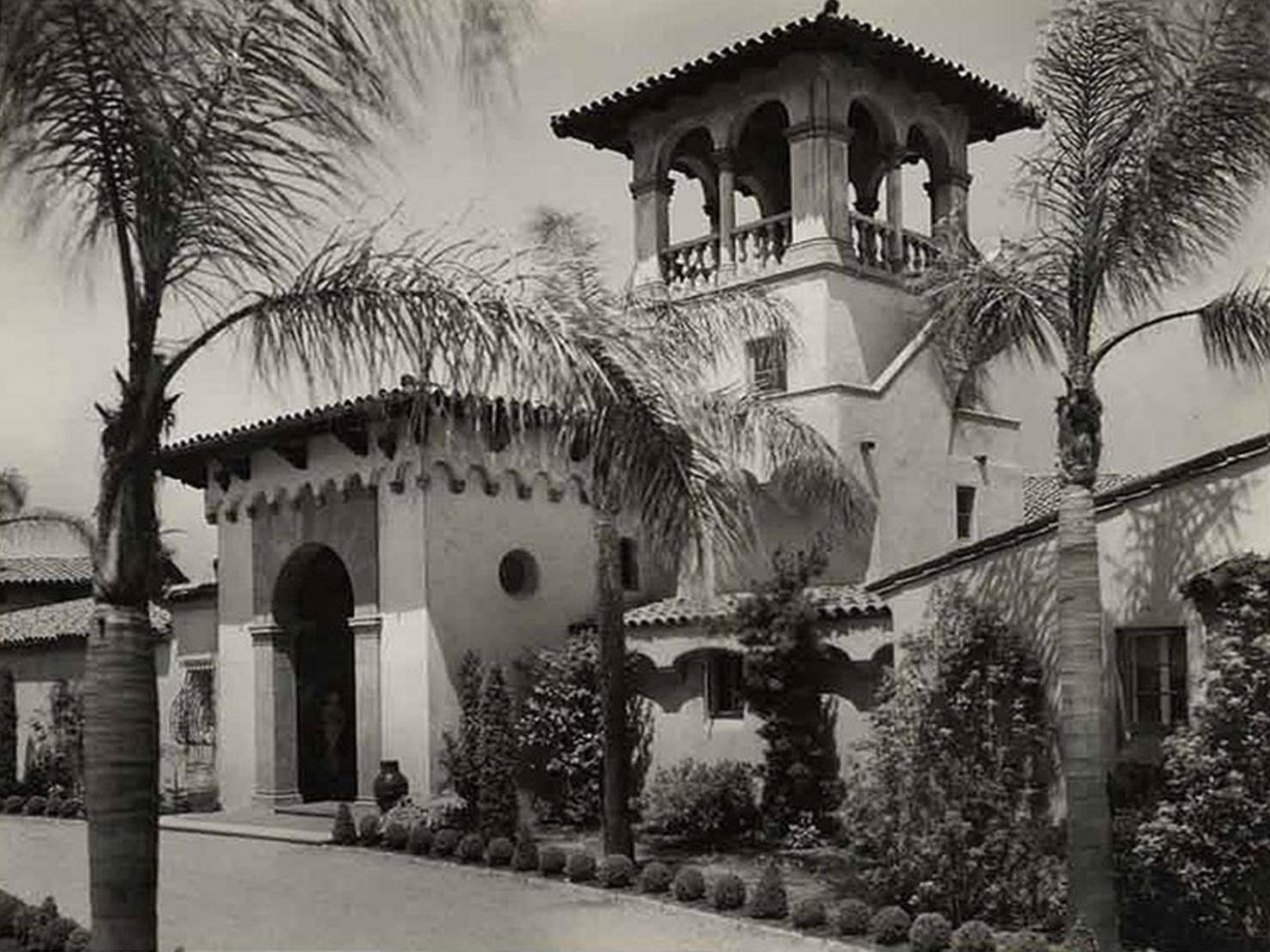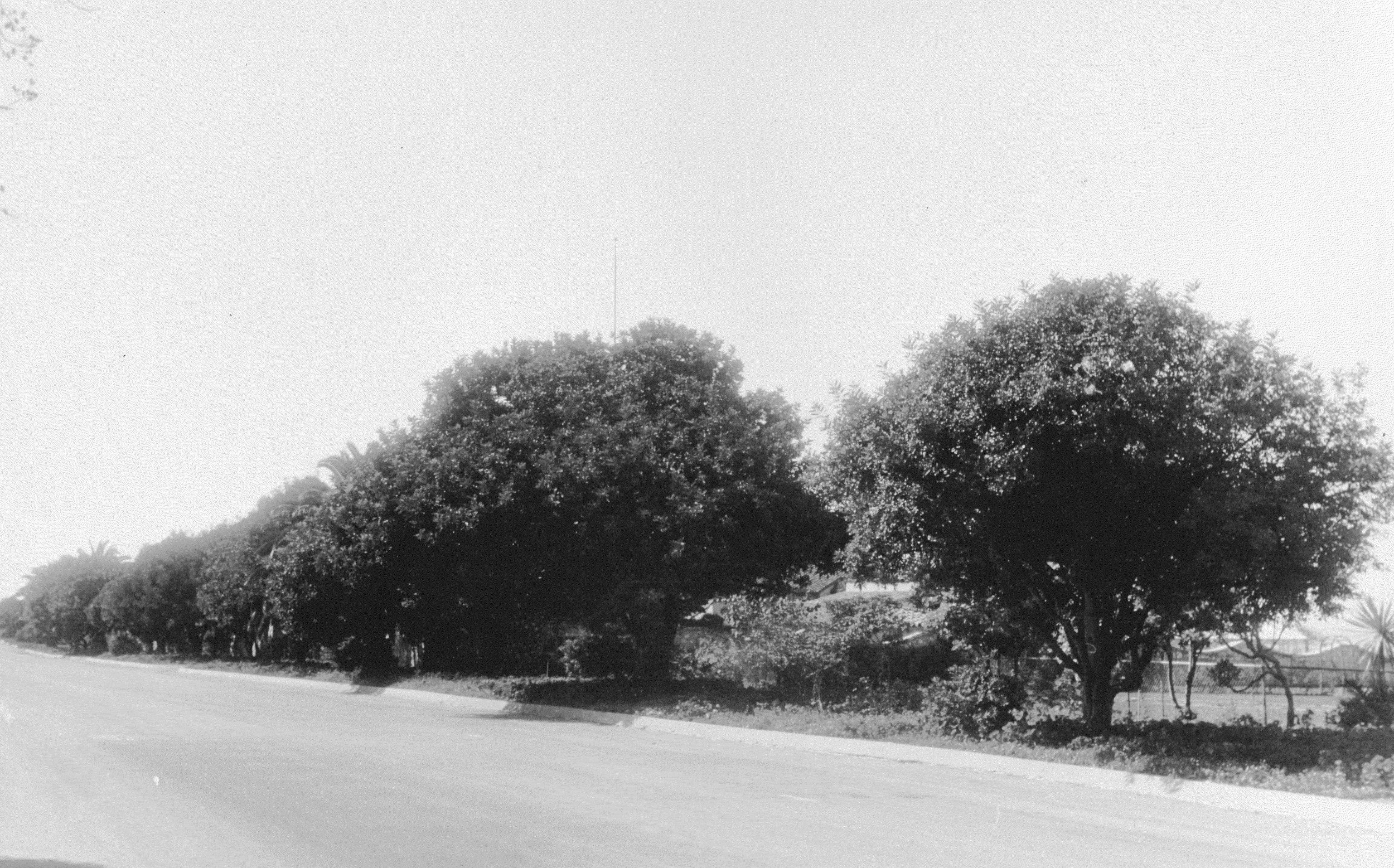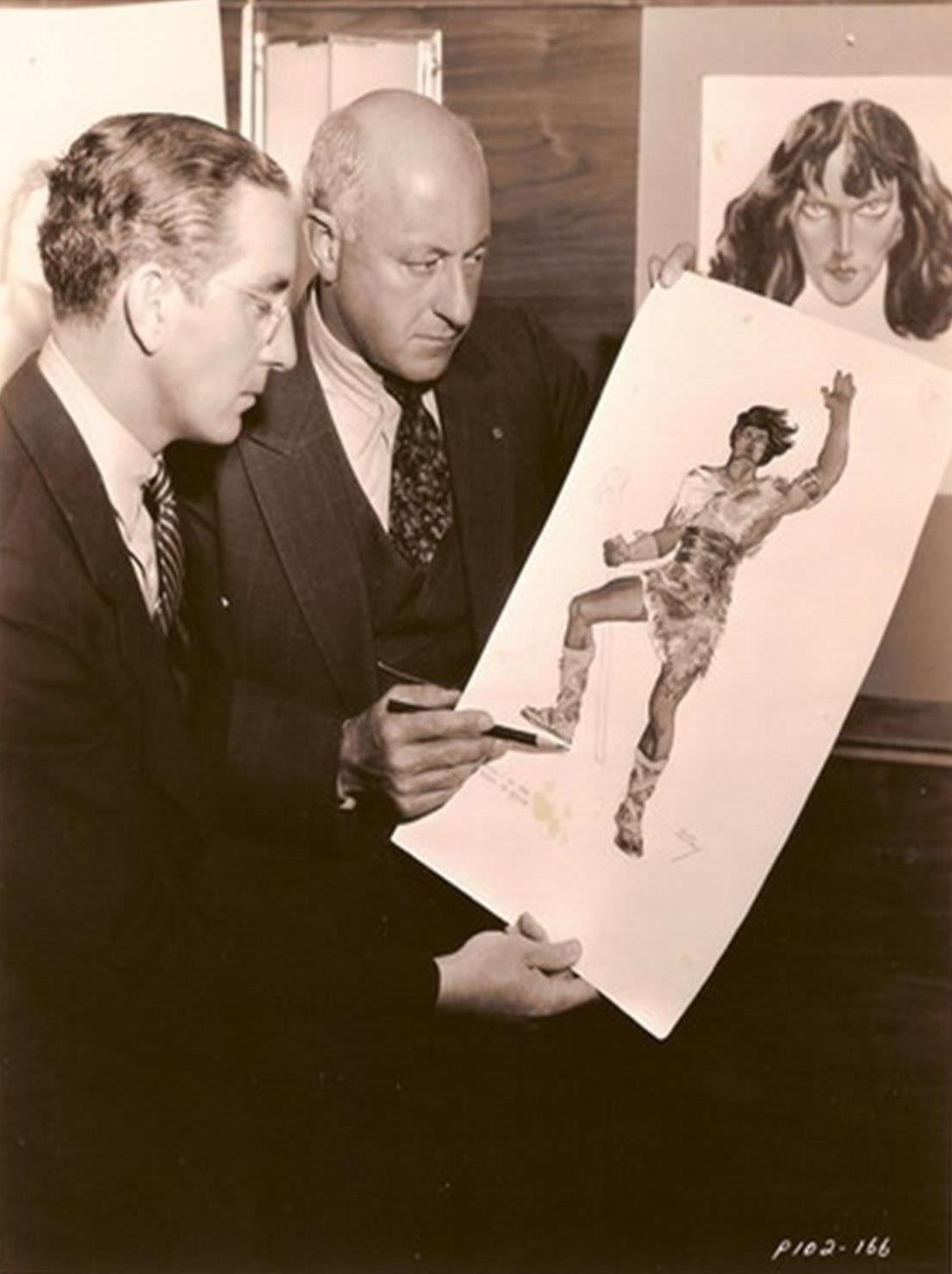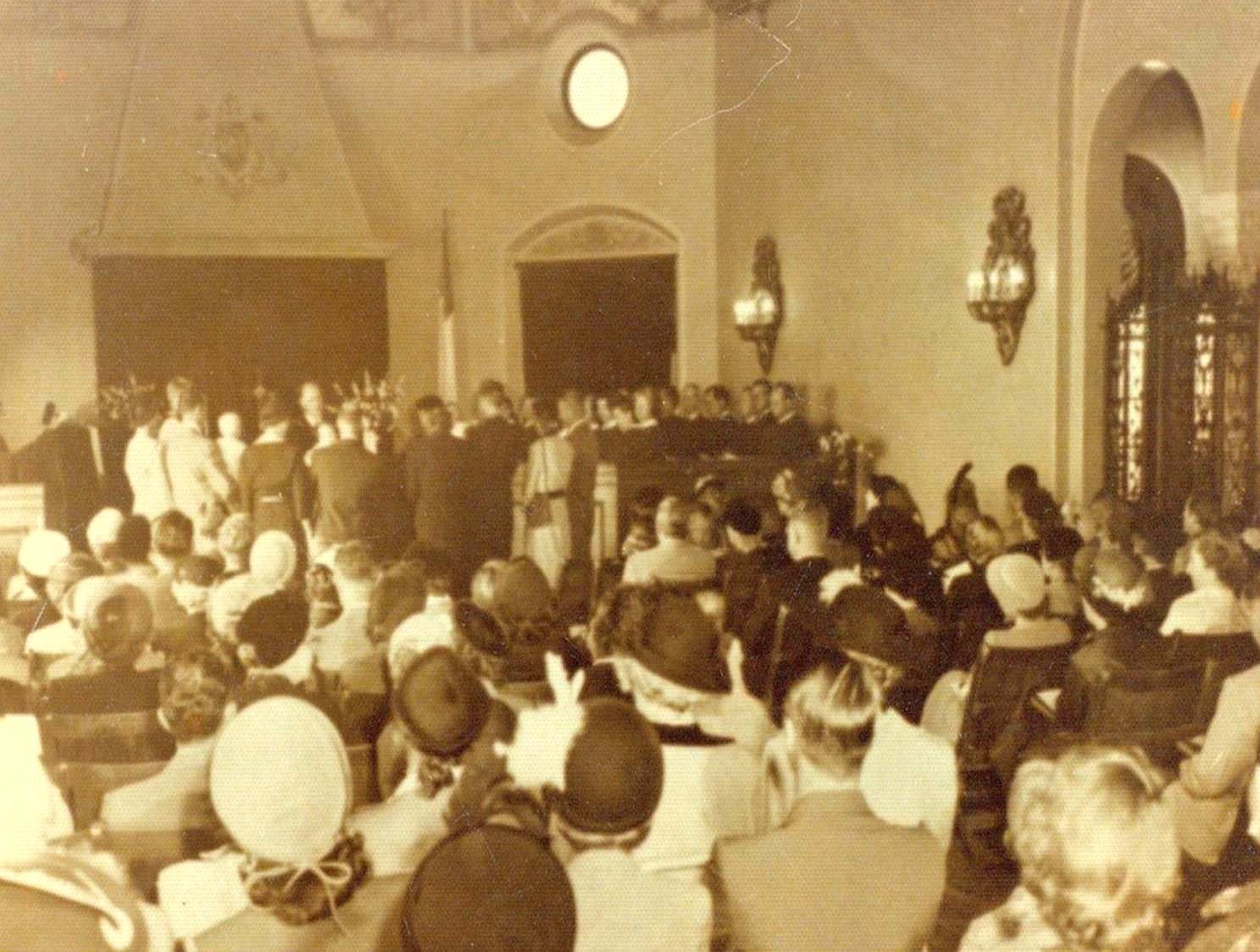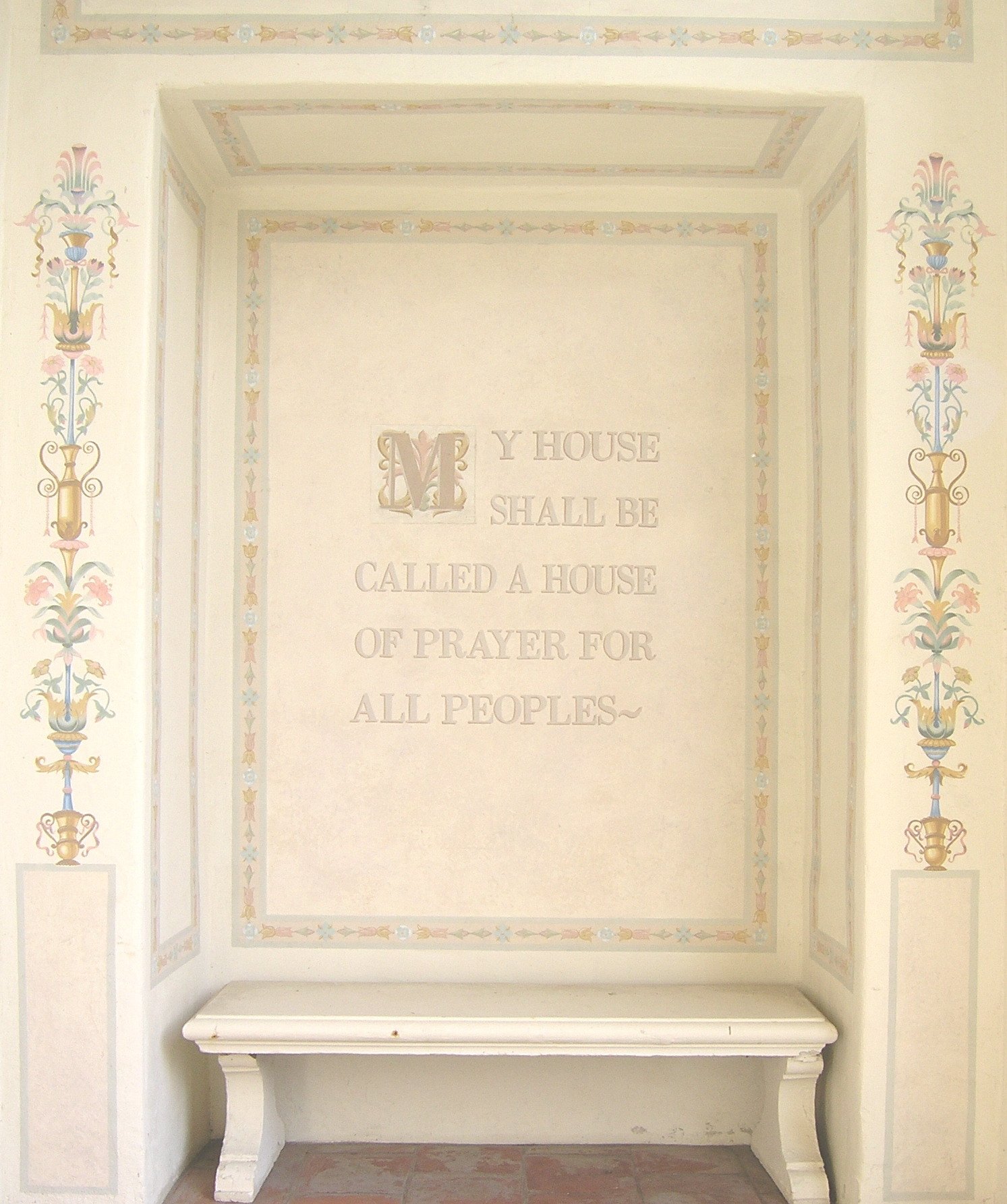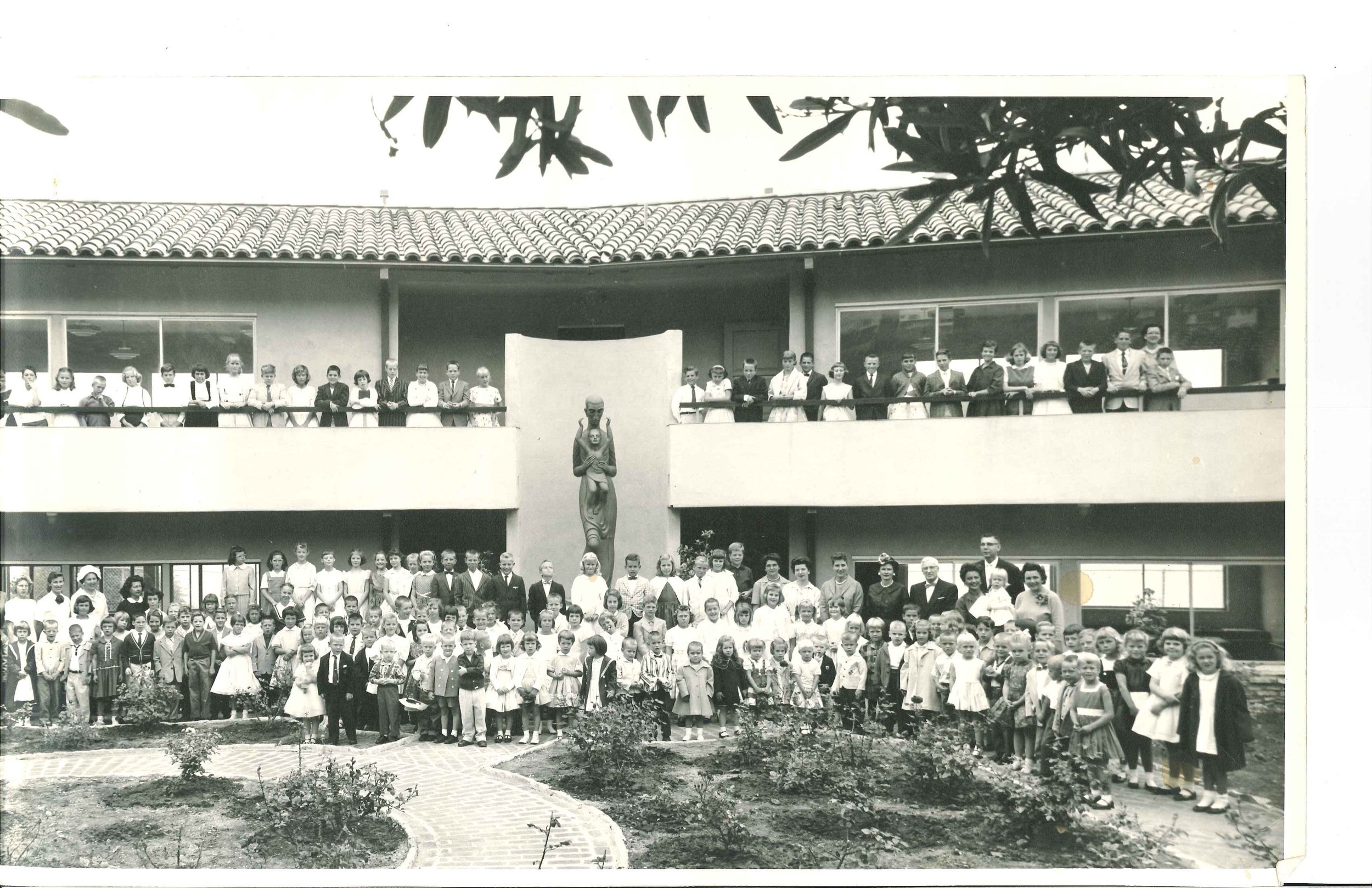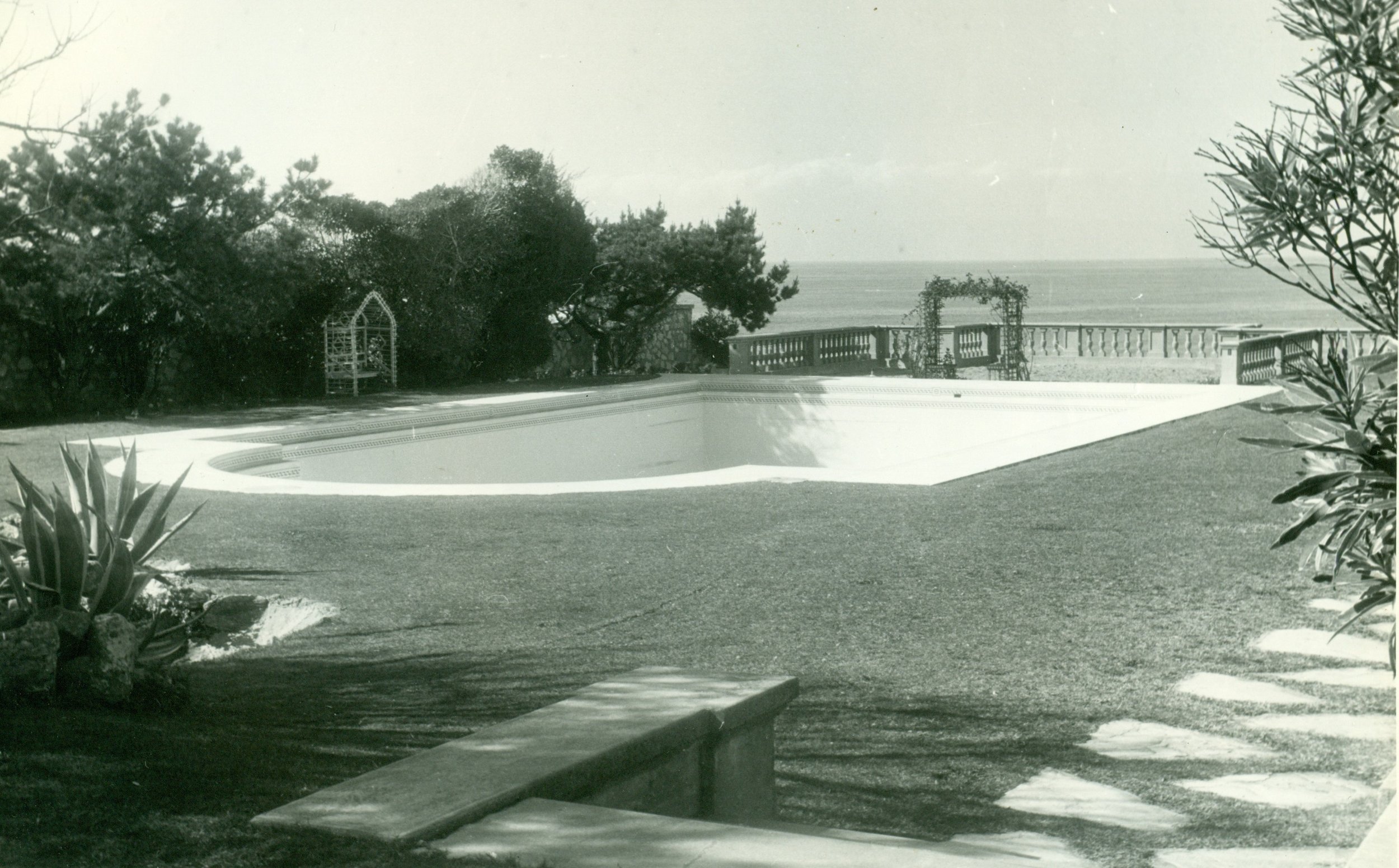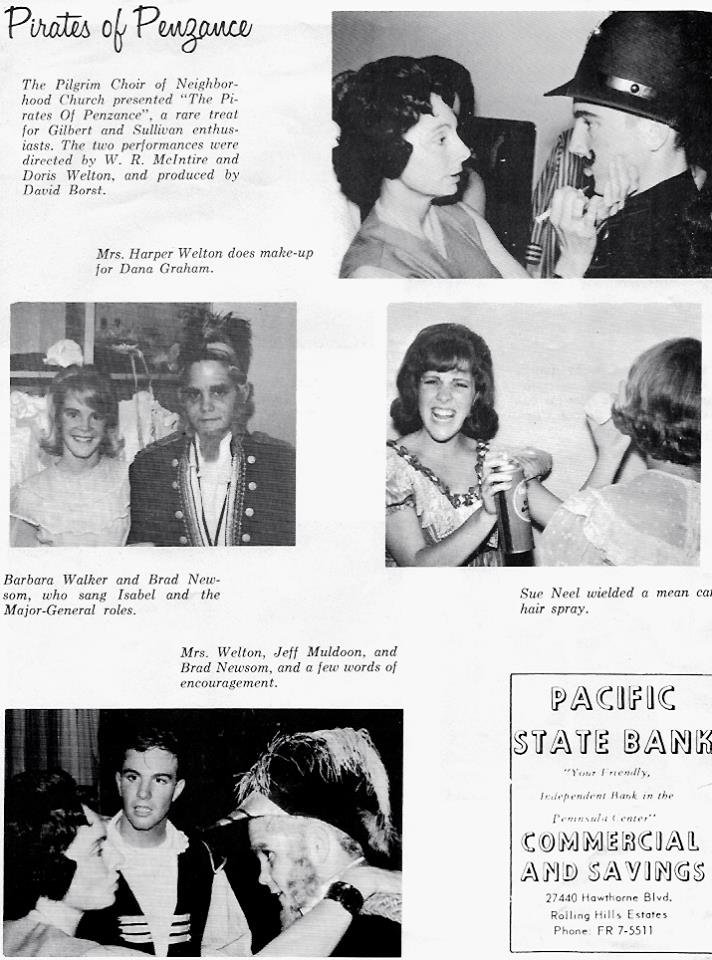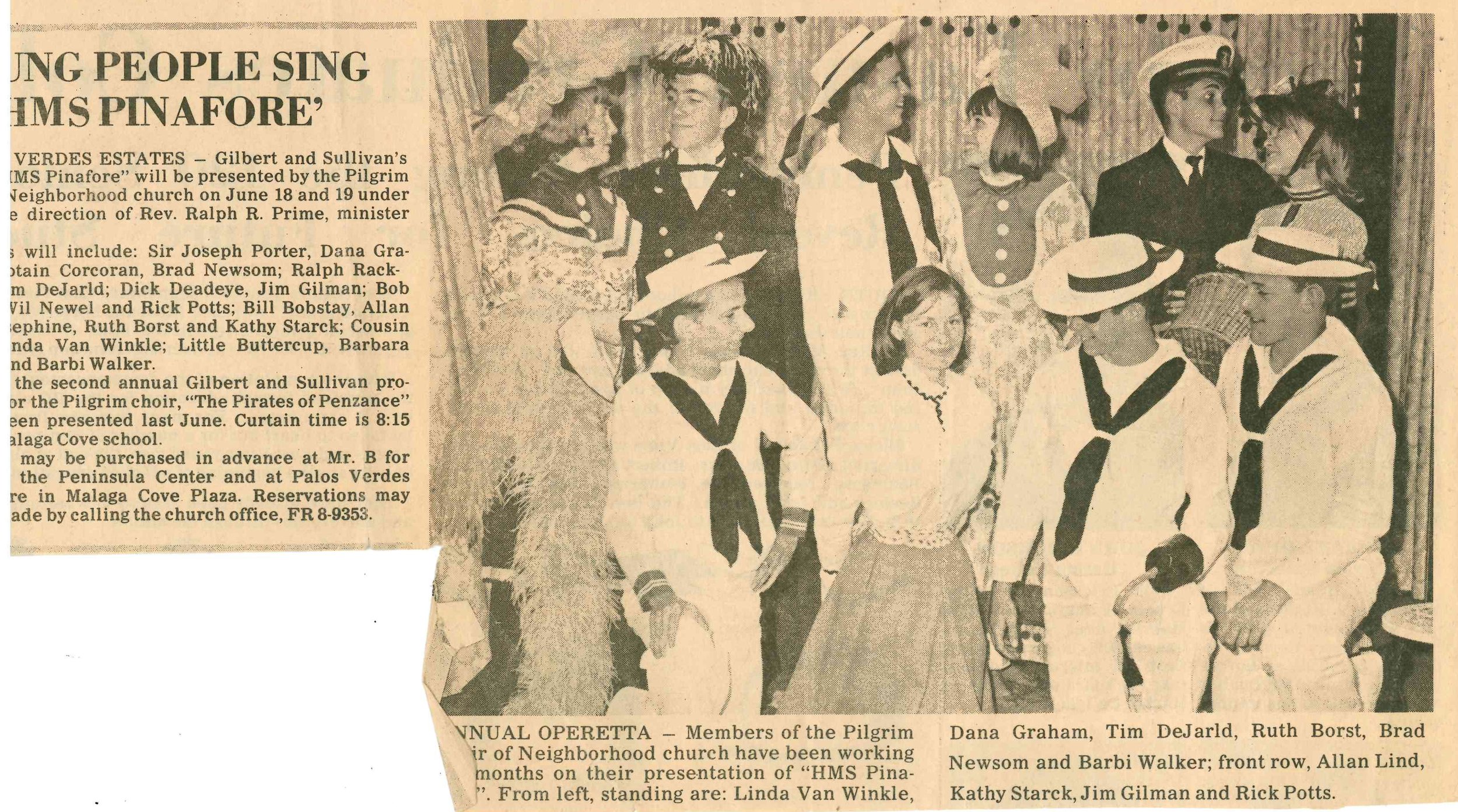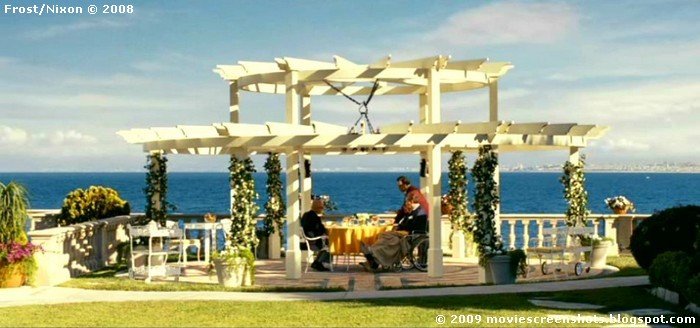History of the Haggarty Mansion/Neighborhood Church – Part 3 – 1949-1996 or so... By Dana Graham, President of the Palos Verdes Historical Society
History of the Haggarty Mansion/Neighborhood Church – Part 3 – 1949-1996 or so...
By Dana Graham, President of the Palos Verdes Historical Society
Image - At the time of purchase
We are now up to 1949. The Neighborhood Church was still meeting at Malaga Cove School, with services held in the auditorium and Sunday School classes in the classrooms. Post-war Palos Verdes was growing by leaps and bounds with returning servicemen starting families and building a lot of 2-3 bedroom 1200-1800 square foot houses generally in Palos Verdes Estates, which was the only city on the Hill at the time – the rest being unincorporated Los Angeles County. My parents were among them, still living at 3405 Via Palomino, but building a house on Via Pinzon.
In 1949, Neighborhood Church got word that Malaga Cove School, badly in need of additional classrooms, would be dividing up the auditorium for that purpose. This would make it unusable for Sunday worship services, so the church began casting about for a new location. Among the locations considered was right across the street where Via Almar and Via Media come together. The area between those streets was vacant almost to Via Aromitas, and there was some consideration given to buying those lots and building a church there.
Meanwhile, by 1949 the owner of the Haggarty Mansion, Harry Wheeler, had passed away, and the London Exploration Company put the place on the market for $250,000 – a princely sum in those days. By this time the building had suffered from some neglect and animals and homeless people called it home.
The pier
The pool on the West Lawn
Rear garden at the time of purchase
Street view at time of purchase
There has always been so much interest in how the Church acquired the property, that I am going to get into the weeds on it a bit:
Neighborhood Church was in imminent need of a new home and a committee was formed to explore the suitability of the Haggarty Mansion, chaired by none other than Dennis Vincent Smith. On Sunday afternoon, July 9, 1950, there was a tour of the estate for the congregation. Here is the only picture of the meeting held that day on the rear patio to discuss and answer questions about the potential purchase.
Meeting of the Congregation 1950
The congregation met again on September 24 in the Malaga Cove Library Art Gallery and voted to pursue purchase of the property. After members broke their piggy banks and cleaned out their sofas under the cushions, $60,000 was raised for a downpayment. Dennis Smith put a $10,000 mortgage on his house and other prominent members such as Ralph and Lois Jester, Gracie Armstrong, and Ethyl Barrymore contributed relatively large sums.
Ralph Jester with Cecil B DeMille
My parents contributed $500, which would have made their house payments for a year. In late September an offer was put together, flown back to Chicago, and presented to the London Exploration Company by Jobbie Jobson, a member who was also a United Airlines pilot. I surmise that we were asking the London Exploration Company to carry the difference between the $60K and the sale price as a trust deed. The congregation was encouraged to pray for its acceptance.
Original rear portico
Rear portico looking toward living room
Not long after, Gracie Armstrong received a telegram saying that the London Exploration Company would take the $60K as payment in full. As this was a cash transaction, the escrow was fairly short and November 16th, 1950 escrow closed and the Neighborhood Church owned the property.
Four prominent early members -- Judge Armstrong, Gladys Towle, Gracie Armstrong, Howard Towle
In January 1951, the Palos Verdes Estates City Council voted not to allow its use as a church. Just great – now what? In their defense, the property was zoned Residential; but there was such widespread community support for its conversion from a white elephant to a Church (of which there were none on the Hill at the time) that I’m sure the Trustees didn’t expect much resistance to a zoning change. There were the expected recriminations from the congregation that the committee to pursue the purchase hadn’t done their homework, etc. A Public Relations Committee was then formed, Chaired by Ralph Jester, the costume and set designer for Cecil B DeMille Productions and a very influential guy. My father was on that committee, as was Dennis Smith. Dr Smith was also on the PVE City Council and, along with Gracie Armstrong and other influential members, was twisting arms behind the scenes.
A campaign was immediately launched to whip up public opinion in favor of either re-zoning or a Conditional Use Permit. Concurrent with that, plans were actually made to sell the property if the City could not be convinced to allow its use as a church. In May 1951 the property was opened to a tour of nearby residents. Many PVE residents signed a petition in support of the Church, 780 signatures in all. My father, who was a commercial artist, came up with a series of cartoons in the PV News that gently chided the City for its stance. During this time, Ralph Jester also headed up yet another committee to plan interior renovations of the building to facilitate its use as a church, and the church successfully petitioned the City to change the address from 421 to 415 Paseo Del Mar.
One of my father’s cartoons in the PV News
May 21, 1952 the PV Homes Association (aka: The Art Jury), after 18 months of debate, meetings in smoke-filled rooms, and who knows what, voted to recommend a zoning change to allow use of the property as a church. Following this, work began under Ralph Jester’s leadership to convert the interior, especially the erstwhile living room, for church purposes. Meanwhile, the two lots to the west of the current parking lot acquired by John Thistle in 1934, were sold off to help finance church conversion. The property was now back to Haggarty’s original 5 lots.
In late September, 1952, the PVE City Council approved a Conditional Use Permit (which the Church is still operating under, by the way) and the first service was held in the living room, now the Sanctuary. Here is the only surviving picture of that service
The first service in the new building
Now that we had a building we had to hire a full-time minister. We hired Richard Dawson and his wife Virginia who, with their two daughters (still living in Hermosa Beach), lived in the west end of the building in what had been the master suite.
New minister Richard Dawson and wife Virginia
You may recall my mentioning that animals and homeless had taken up residence in the building, and it wasn’t long before one morning when the Dawsons discovered a vagrant in one of the bedrooms. The City would not allow any kind of sign, cross, or anything else that indicated that this was now a church, so in 1953 Rev Dawson had my dad paint this passage from Isaiah on the right side of the entry. You can still see it there today, along with a few of the pencil lines my dad drew in 1953 to ensure that the lines were straight.
Just inside the entry
Ralph Jester had been at work converting the living room into a sanctuary. Here is a picture of how it looked for the first Christmas in the new building. A drapery covers the fireplace and the two large windows on either side, and a pulpit, choir loft, and altar had been constructed out of mahogany, along with matching cabinetry in the entry hall, now known as the narthex. The last time I was in the building in 2016, much of that original cabinetry was still there.
The first Christmas 1952
My mother, Ruth Graham, was a very accomplished pianist and took over from Gladys Towle as the church organist once we moved into the building. Initially we had a Hammond electric organ which she practiced on every Thursday afternoon, and she would bring my sister and I down to the church. Here we are in 1956 on the back patio with my friend Jimmy Schmitz.
My sister, Jimmy Schmitz, and me on the rear patio in 1956
Beginning in 1953 we staged the Christmas Pageant, essentially the story of the birth of Christ. Once again, Ralph Jester was of enormous help not only getting the sets built but also supplying the costumes. This is still a tradition at the Church and, after a brief service in the sanctuary, you walk the grounds and view depictions of the various events described in the Bible – The Annunication, shepherds in the field, the 3 kings, Herod’s Court, and the manger scene, among others. Needless to say, there is a lot going on and there have been hilarious things happen over the years: I remember once in the 1980’s when the live sheep that were being tended by the “shepherds in the field” escaped and ran down Paseo del Mar. The Pageant was due to start in 30 minutes and we were all chasing the sheep down the street. The 3 kings scene is at the pond with the kings crossing the bridge and young girls dressed as angels standing around the pond. Every so often we would hear a splash as one of them had fallen in.
Christmas Pageant
Herod’s Court
Also in 1956 it was decided that we really should have our own Sunday School building rather than continue to use Malaga Cove School, so ground was broken in the former rose garden, along the bluff.
Sunday School staff 1955
Church member Rocky Wood was an architect and the cost was $75.000, finished in late 1957. This is the long white building you can see from Redondo. We all marched over from Malaga Cove School and posed on the balconies.
Groundbreaking for the Sunday School 1956
Groundbreaking for the Sunday School 1956, Dennis Smith on the left
Us kids walking over from Malaga Cove School to the new Sunday School building
Standing on the balcony 1958
Also about this time, the insurance company was balking at the liability of having a pool (and an unfenced pool at that) on the property, especially since we weren’t Baptists. There was one last swim for organized for all us kids (it had always smelled of sulphur and wasn’t that pleasant), and the pool was filled in. If you visit the Church, you can still see the original tile along the sidewalk on the north end of its former location.
Another view of the pool 1952
Looking east 1952. Seen pool tile lower right.
Covenant Choir 1963
High School Choir 1963
There were various other events and activities over the years. In the 1960’s the high school choir had about 45 members (the Baby Boom having come to fruition) and beginning in 1964 we staged complete Gilbert & Sullivan musicals at the new Malaga Cove School auditorium, where the old tennis courts had been.
Getting ready for Pirates of Penzance
I was Sargeant of Police
HMS Pinafore
Ruddigore
In the 1960’s and ‘70’s on the 4th of July the youth group put on the Ice Cream Social on the back patio. We served (guess what) ice cream obtained from Baskin Robbins in the Riviera plus I can’t remember what else. One of the highlights (if you ask me) was a performance by my barbershop quartet, The Fourmaldehydes. There would also be a charity auction, after which everyone would stick around to watch the 4th of July fireworks from the rear patio – a hard-to-beat location. There must be pictures of this big annual event, but I don’t have them.
The Fourmaldehydes at the Hollywood Bowl
In 1975 Dennis Smith, probably the most significant person in the history of the Church passed away.
Dennis Smith upon his retirement
Many church members who knew him and Hazel were still around and made a “memory” book for Hazel. My father painted a watercolor of the Church for the cover, which was later re-produced and sold to raise money for Church projects. I can’t tell you how many homes in PV I seen this picture hanging in. By the way, the 8/75 at lower right is the date he painted it – it is not #8 of 75.
My father’s watercolor of the church 1975
By this time the pier had mostly collapsed. The water-wheel by the cave lasted until 1979. In 1994 we raised money to build a new social hall down on the east end of the building, which wiped out the original kitchen, servants’ quarters, 6-car garage, and the old volleyball court where countless games were played by the youth groups over the years. This was probably the most major project undertaken by the Church since the purchase of the building, and Chairman of the Trustees David Buxton deserves a ton of credit for seeing it thru. As a condition of the permit to build the new social hall, we also had to replace the original seawall along the base of the cliff and re-engineer the drainage across the west parking lot, across which flows much of the run-off from the north side of the Hill. The appearance of the Church has changed little since this time.
See water wheel at center soon after construction
In the early 2000’s the Church served as the Western White House for the movie Frost-Nixon. Here is a picture of the actors portraying them sitting the Labyrinth dedicated to longtime member Miriam Levonian overlooking the ocean. Not long after that I was on the Board of Trustees, in charge of Building and Grounds. I found out then what it cost to maintain that place. We did a light remodel on the Sunday School building, and dealt with an infestation of raccoons in the attic above the sanctuary. This had been a problem for years and I was determined to solve it. The raccoons were evidently music critics and relieved themselves above the soprano section of the choir loft, which seeped thru the plaster ceiling with predictable results. That place was built with no access to that attic (who signed the permit, anyway?), so we cut a hole in the roof and made a hatch for access. We tried everything to get the raccoons to abandon the attic – blasted heavy metal music into the attic and when that didn’t work, tried Stravinsky and Schoenberg, which I believe did the trick. Would have for me; in fact, I had to leave . . . oh never mind.
Filming of Frost-Nixon
I hope this 3-part history of Neighborhood Church has been as enjoyable for you to read as it was for me to re-live. These are just my personal memories. I am sure I’ve left out special memories of many people over the past 75 or so years. Please direct any complaints to the head of Complaint Department, Xavier Breath. But seriously, email me with any comments or additions. And thank you for reading.
Dana Graham, real estate expert, historian, PV Native and you can find Dana at www.danagraham.com
Dana is President of the Palos Verdes Historical Society.

